|
I managed to capsize our MikesBoat
yawl during the second day, Tuesday, May 25, of the 2010 OBX (outer
banks) 130 in Core Sound, North Carolina. The fleet departed Cedar
Island the day before in a moderate east wind that was predicted
to back to the NE and strengthen.
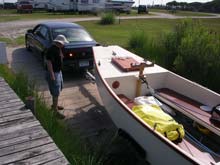 |
Launching at Driftwood Motel, Cedar Island,
North Carolina. |
A small craft advisory was posted for the afternoon of Monday
through Thursday. Monday night’s destination was an abandoned
gun club on the barrier island that makes up part of the Cape
Lookout National Seashore. During the night, I heard the wind
increasing as it kept the rain fly of my solo tent in constant
motion. Morning brought a forecast of NE winds 20 to 25 kts.
Being new to this type of cruising and not having much heavy
air experience with the MikesBoat, I decided to withdraw from
the event and head for Harker’s Island a few hours south
where I could get a ride back to my car and trailer. Before leaving
the gun club, I put in the second reef in my main before hoisting
both it and the mizzen.
At first all was well as the boat was consistently sailing fast
and feeling secure on a broad reach with the wind coming over
the starboard quarter, both sails eased out to port, and with
the leeboard down about one third. After about an hour, however
the wind and waves continued to build to the point where I thought
that I should come up into the wind, lower the main, and continue
on under mizzen alone. Within ten minutes of that thought, I was
in the water.
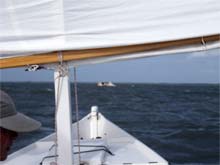 |
Andrew Linn took this from Laguna Dos. Asked
about the focus, he later said: "I have issues with photographing
other people's tragedies." |
To the best of my memory, the stern of the boat was swung off
to port (possibly by wave action?) causing a heel to starboard,
the WINDWARD side of the boat. Releasing the main sheet and pulling
the tiller to take the boat back downwind did not stop a capsize
to WINDWARD. I noticed that the boat was riding high on her side
with the mast angled down into the water. I swam around to the
bottom of the boat and climbed onto the leeboard, but that did
not right the boat.
At this point, Laguna
dos sailed by and the crew asked if I could right the boat
myself, to which I replied that I could not. A moment later, Sean
Moffitt from Laguna dos appeared in the water next to
me and suggested that we try to point the boat into the wind.
We were unable to do this, but he further suggested that we try
to furl the main. Furling was successful, and I once again stood
on the leeboard causing the boat to right easily.
Sean quickly climbed aboard, but I was unable to do so. I hooked
a foot over the wale, and Sean literally dragged me aboard. After
expressing my thanks, I was amazed to see a foot or less of water
in the boat that we were able to bail out quickly. We then proceeded
to Harker’s Island under power where Sean was able to rejoin
Laguna dos, and I was able to retrieve my car and trailer
and haul out for the trip back to Michigan.
Even a quick reading of the above shows that I made several
mistakes.
1. I should have acted the moment that I sensed that the boat
was overpowered.
2. I could have started with just the double-reefed main.
3. Instead of using the main, I could have set the small jib from
my West Wight Potter that I had with me using a cleat on the foredeck
for the tack and the main halyard. This would have moved the center
of effort forward and possibly prevented the round up and capsize.
4. I should have made provision for a boarding ladder. We intentionally
did not add the toe hole in the rudder that Jim Michalak suggests
believing that it would take away form the rudder’s efficiency.
5. I was most certainly using the boat in conditions that the
boat was not designed for.
I was very lucky in that the water was warm and the boat capsized
to starboard so that the leeboard was available to help right
the boat. By far, my greatest luck was Sean Moffitt’s
willingness to lend a hand while inconveniencing himself.
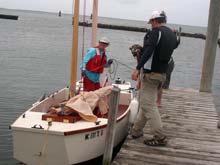 |
Tying up at Harker's Island. |
Looking ahead I know that I must add a boarding ladder and devise
a system to right the boat if the leeboard is out of reach. A
few decades ago, I raced a NACRA 5.8 catamaran. We always carried
a coiled righting line under the trampoline that could be thrown
over the upper hull to right the boat in the event of a capsize.
My crew and I used it more than once!! For the MikesBoat, I believe
that a line could be connected to a strong point inside the wale
on the port side of the boat. In the event of a port side down
capsize, the line could be thrown over the vertical hull, led
over the leeboard, and then used to right the boat. In the event
of a retracted leeboard, a STRONG person might climb it a bit
to reach the leeboard. Alternately, loops could be tied in the
line for foot holds to reach the leeboard.
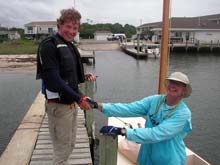 |
I was so grateful for Sean's help that I gave
him the rigging knife that I have carried for 30 years. |
This experience has not dampened my enthusiasm for the MikesBoat
yawl. I believe it is a very versatile and comfortable daysailor/beach
cruiser/expedition craft far more capable than its length might
indicate. I will handle the boat with more care off the wind in
the future and will work on the modifications listed above.
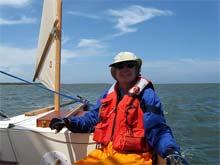 |
At the helm on day 1 - notice the nice weather.
More of this please. |
*****

|

